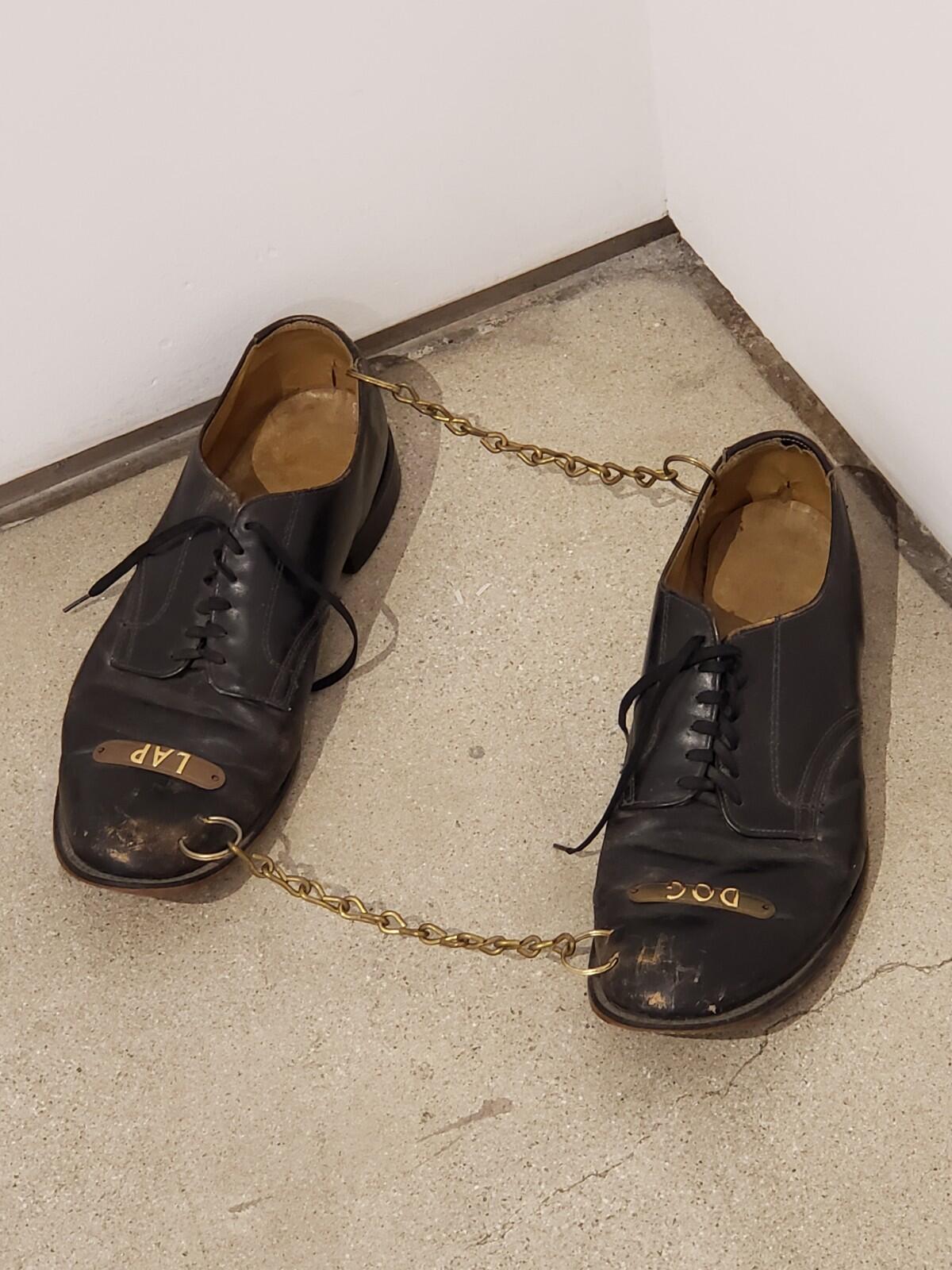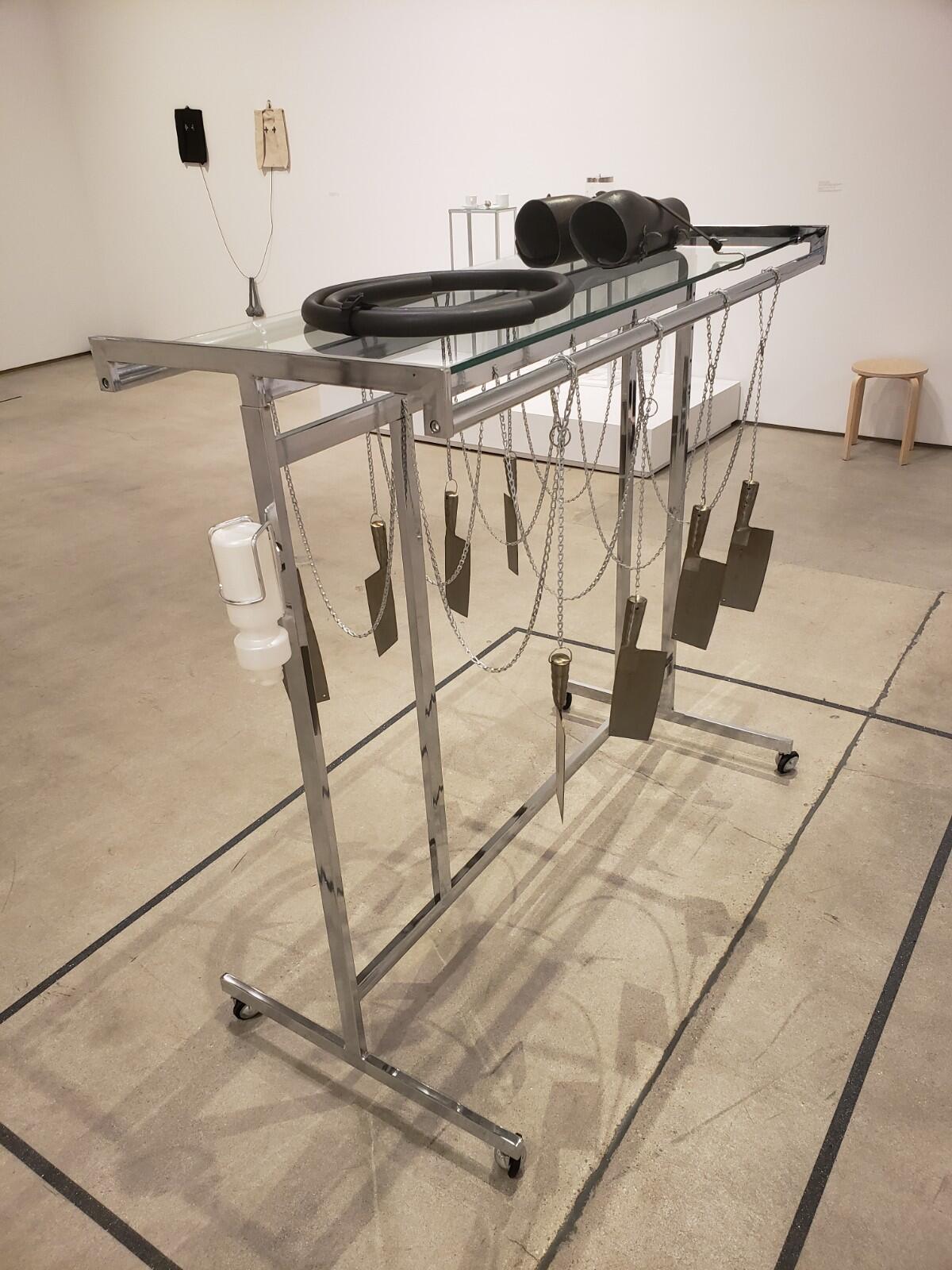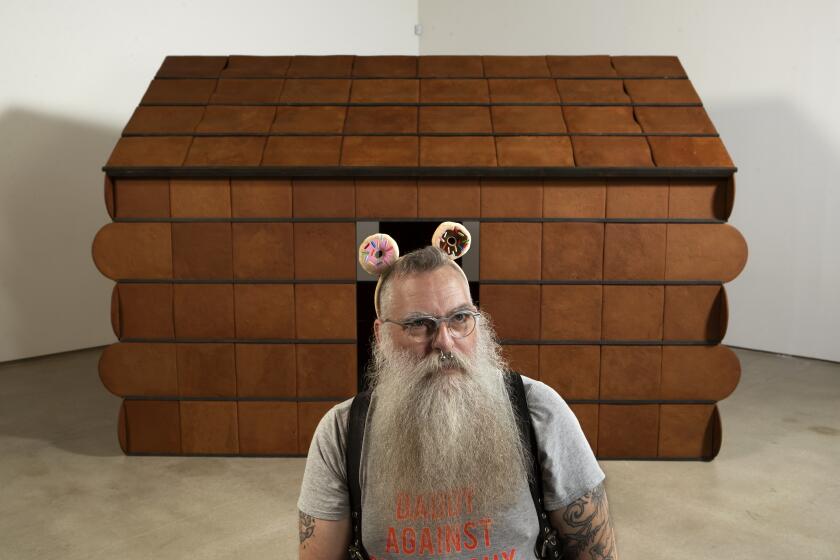Nayland Blake turns bunnies and shoes into meditations on sex, power and prejudice

- Share via
You won’t find one of artist Nayland Blake’s sassy rabbits, which have been a common feature of the artist’s work, in the vast collection of Altadena’s cheerful Bunny Museum. In drawings, sculptures and videos, Blake’s rabbits tend to exude a mordant humor of layered depth.
The playful title of a welcome retrospective at the Institute of Contemporary Art, Los Angeles, suggests how.
With a nod toward bodily orifices, “No Wrong Holes: Thirty Years of Nayland Blake” is at once sexually suggestive and sorrowful. It affirms the profound influence and satisfactions of human desire. Simultaneously, it acknowledges the deep pit of unavoidable loneliness that accompanies it — a hole in the heart.
In China, babies born during the Year of the Rabbit are said to be sensitive to beauty. In the West, given the regeneration associated with the Easter bunny and the erotic power dynamics of the Playboy logo, the bunny has long been a — you should pardon the expression — fertile symbol.
“Starting Over,” Blake’s 23-minute video projection in the final room, sweeps up all these elements (and more) into one. Dressed in a heavy, absurdly oversize bunny suit weighing 146 pounds, the artist climbs on a stage wearing tap shoes, commencing to dance until collapsing, exhausted. The volume of the tapping feet is turned way up, crashing like nonstop thunder.
The video is elegiac, the absurd suit’s heaviness equaling that of a romantic partner at the time. The rabbit frames a personal story that incorporates the physical intimacy of sexual coupling and the emotional intimacy of “starting over,” which any partnership entails. Blake carries the relationship’s weight.
Projected on the usual white gallery wall, the costume, pedestal-stage and backdrop are likewise white. With purity and innocence as context, a sweet romanticism sneaks into the raucous, noisy display of tap-dancing as fast as one can.
The video is also a wry, even poignant take on any artist’s role in offering public enactments of private truths. Blake is out there, exposed, for everyone to see — good, bad or indifferent. It’s grueling, certainly; but this self-critical work is also generous: Performance art takes its toll on everyone concerned, the artist as well as an audience standing in a room watching and waiting.
Blake is a skilled draftsman, as five selections in graphite and colored pencil from the series “After the Turner Diaries” attest. Rabbits dig in the dirt, are pulled from a magician’s hat, boil in oil.
They’re drawn in a range of styles that include vernacular formats of graffiti and cartooning. Evoked is Brer Rabbit, a character descended from African folklore and concocted at the dawn of the Jim Crow era by Joel Chandler Harris. The rabbit is a Southern trickster who survives by his shrewdness and brain power rather than muscle.
Blake’s series, begun in 1996, dates from the shocking aftermath of the 1995 Oklahoma City bombing. Like most domestic terrorism, the attack was performed by a white supremacist. This one was enamored of “The Turner Diaries,” the infamously racist and anti-Semitic novel.
Blake, the son of an African American father and an Irish American mother, is light-skinned; the African American heritage is easily missed. Like Conceptual artist Adrian Piper, whose work has also dealt with racial passing, Blake’s conflicted life experience has informed the art in distinctive ways.
In the dominant society, which includes the art world, the New York-based artist is socially an outsider who seems to be an insider. Blake’s affinity for same-sex love, however, puts them back on the outside — Blake uses non-binary gender pronouns — especially during the 1980s, when they first emerged as an artist. The bunny is a symbol for the stereotypes of black and gay cultures as naturally oversexed.
The rabbit imagery also draws on the influential work of other artists. One is the social sculpture of German artist Joseph Beuys, who tried to explain the mysteries of painting to a dead hare gently cradled in his arms in a famous 1965 performance piece. Mike Kelley’s assemblages of used stuffed-animals are another, including fuzzy bunnies that radiate complexities of childhood longing and trauma.

The exhibition, organized by ICA LA curator Jamillah James, opens with a selection of “restraint” sculptures that Blake made in the late 1980s and early 1990s, pre-rabbit. (The artist graduated from CalArts in 1984, later moving to San Francisco for a decade before settling in New York.) Works like “Lap Dog,” a pair of dressy black shoes linked by golden chains, use the visual language of the sexual subcultures of bondage-and-discipline and sadomasochism to complicate assumptions about a spectrum of social relations.
The chains easily evoke slavery and criminality, the joined shoes tripping up the possibility of easy escape. BDSM, however, rejects coercion in favor of psychological discovery through willing participation. Both interpretations, the political and the sexual, raise an eyebrow at the ordinary rituals of conventional society, which the spiffily shined dress shoes and polished golden ornaments suggest.
How to get along in corporate culture? Lap dog is one answer.
Blake has a way with creating slippery tectonics through carefully orchestrated means. Nothing stays in its prescribed lane. The “Lap Dog” shoes, in a witty installation move, stand on the floor tucked into a gallery’s corner, as if the sculpture has been left behind by a naughty boy who seems to have slipped away.
“Work Station #5” pushes the motif to hair-rising limits.
A tall, sleek, metal-and-glass table, like something from a science lab or hospital operating room, is festooned with eight meat cleavers suspended on elegant chains, four dangling from either side. A coil of black rubber hose and two black leather shin and calf guards are laid out on top, while a plastic water bottle is affixed to one end.
As you peruse the display, everything from healing to torture floats through your mind. Both prospects are tethered to conflicting notions of the risks of experimentation.
Power dynamics are the sculpture’s disconcerting subject, and the formidable forces at work include the power of aesthetics. Those are not always clear-cut.
Playful works imbued with darkness, kink and sugary baking scents are part of Nayland Blake’s 30-year retrospective “No Wrong Holes” at ICA LA.
The sculpture is emphatically Modernist in design. It’s like something conceived in a utopian spirit by the avant-garde artists of the 1920s Bauhaus in Weimar, Germany, then appropriated for cruelty by Third Reich thugs and finally reissued into the upscale domestic consumer market by the minimalist manufacturers at Design Within Reach.
It’s worth noting that “Work Station #5” dates from 1989. That’s the year that artist Robert Mapplethorpe died from AIDS, one among 100,000 cases recorded by the time the derelict U.S. Congress finally created the National Commission on AIDS, after nearly a decade of deadly dithering. Blake’s wheeled sculpture is an emergency crash cart. Sex, medicine, prejudice, clinical cruelty and more are smashed together.
Perhaps the most touching work is an assemblage featuring Madame, the wisecracking puppet created by comedian Wayland Flowers, felled by AIDS a year before Mapplethorpe. Glamorous Madame, like Mae West and Sophie Tucker before her, was a vaudevillian mistress of the often-ribald double-entendre. She spoke her mind.
Madame could say what Flowers couldn’t, even though he was standing right next to her manipulating her puppet-limbs and moving his lips, a young gay man projecting through an old heterosexual lady. Blake’s sculpture, wryly titled “Magic,” displays the now-silent surrogate inside a coffin-like carrying case — sort of like the closing bracket for Judy Garland, born in a trunk at the Princess Theater in Pocatello, Idaho. Laid out before Madame is a big, mournful mound of dried roses, Flowers in absentia.
That’s the kind of multifarious, heterogeneous quality that characterizes Blake’s best work, where puppets and bunnies are rife. One way to overcome alienation and isolation is to recognize that identity might be singular, unique to every individual — but that doesn’t mean it is fixed, static or even benign.
What it feels like to live in your body making choices is the frequent nexus between a viewer and Blake’s art. Nowhere is the experience more disturbing than in watching “Negative Bunny,” a 30-minute video that features a fluffy stuffed animal.
By turns cheerful, desperate and portentous, the rabbit looks straight into the camera and begs for sex, insisting all the while that it has been tested and can guarantee being free of HIV. At once cuddly and bullying, ridiculous and dark, frightening and fun, this inanimate toy is a bunny who is negative in more ways than one.
'No Wrong Holes: Thirty Years of Nayland Blake'
Where: Institute of Contemporary Art, Los Angeles, 1717 E. 7th St.
When: Wednesdays-Sundays, through Jan. 26
Admission: Free
Info: (213) 928-0833, theicala.org
More to Read
The biggest entertainment stories
Get our big stories about Hollywood, film, television, music, arts, culture and more right in your inbox as soon as they publish.
You may occasionally receive promotional content from the Los Angeles Times.












